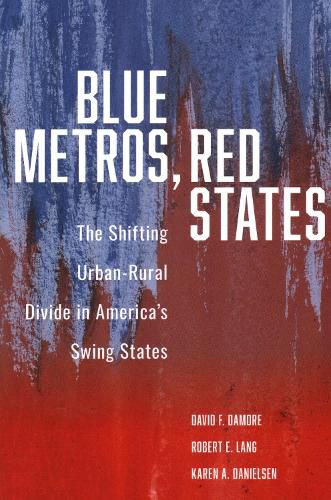Readings Newsletter
Become a Readings Member to make your shopping experience even easier.
Sign in or sign up for free!
You’re not far away from qualifying for FREE standard shipping within Australia
You’ve qualified for FREE standard shipping within Australia
The cart is loading…






This title is printed to order. This book may have been self-published. If so, we cannot guarantee the quality of the content. In the main most books will have gone through the editing process however some may not. We therefore suggest that you be aware of this before ordering this book. If in doubt check either the author or publisher’s details as we are unable to accept any returns unless they are faulty. Please contact us if you have any questions.
Assessing where the red/blue political line lies in swing states and how it is shifting.Democratic-leaning urban areas in states that otherwise lean Republican is an increasingly important phenomenon in American politics, one that will help shape elections and policy for decades to come. Blue Metros, Red States explores this phenomenon by analyzing demographic trends, voting patterns, economic data, and social characteristics of twenty-seven major metropolitan areas in thirteen swing states-states that will ultimately decide who is elected president and the party that controls each chamber of Congress.
The book’s key finding is a sharp split between different types of suburbs in swing states. Close-in suburbs that support denser mixeduse projects and transit such as light rail mostly vote for Democrats. More distant suburbs that feature mainly large-lot, single-family detached houses and lack mass transit often vote for Republicans. The book locates the red/blue dividing line and assesses the electoral state of play in every swing state. This red/blue political line is rapidly shifting, however, as suburbs urbanize and grow more demographically diverse. Blue Metros, Red States is especially timely as the 2020 elections draw near.
$9.00 standard shipping within Australia
FREE standard shipping within Australia for orders over $100.00
Express & International shipping calculated at checkout
This title is printed to order. This book may have been self-published. If so, we cannot guarantee the quality of the content. In the main most books will have gone through the editing process however some may not. We therefore suggest that you be aware of this before ordering this book. If in doubt check either the author or publisher’s details as we are unable to accept any returns unless they are faulty. Please contact us if you have any questions.
Assessing where the red/blue political line lies in swing states and how it is shifting.Democratic-leaning urban areas in states that otherwise lean Republican is an increasingly important phenomenon in American politics, one that will help shape elections and policy for decades to come. Blue Metros, Red States explores this phenomenon by analyzing demographic trends, voting patterns, economic data, and social characteristics of twenty-seven major metropolitan areas in thirteen swing states-states that will ultimately decide who is elected president and the party that controls each chamber of Congress.
The book’s key finding is a sharp split between different types of suburbs in swing states. Close-in suburbs that support denser mixeduse projects and transit such as light rail mostly vote for Democrats. More distant suburbs that feature mainly large-lot, single-family detached houses and lack mass transit often vote for Republicans. The book locates the red/blue dividing line and assesses the electoral state of play in every swing state. This red/blue political line is rapidly shifting, however, as suburbs urbanize and grow more demographically diverse. Blue Metros, Red States is especially timely as the 2020 elections draw near.